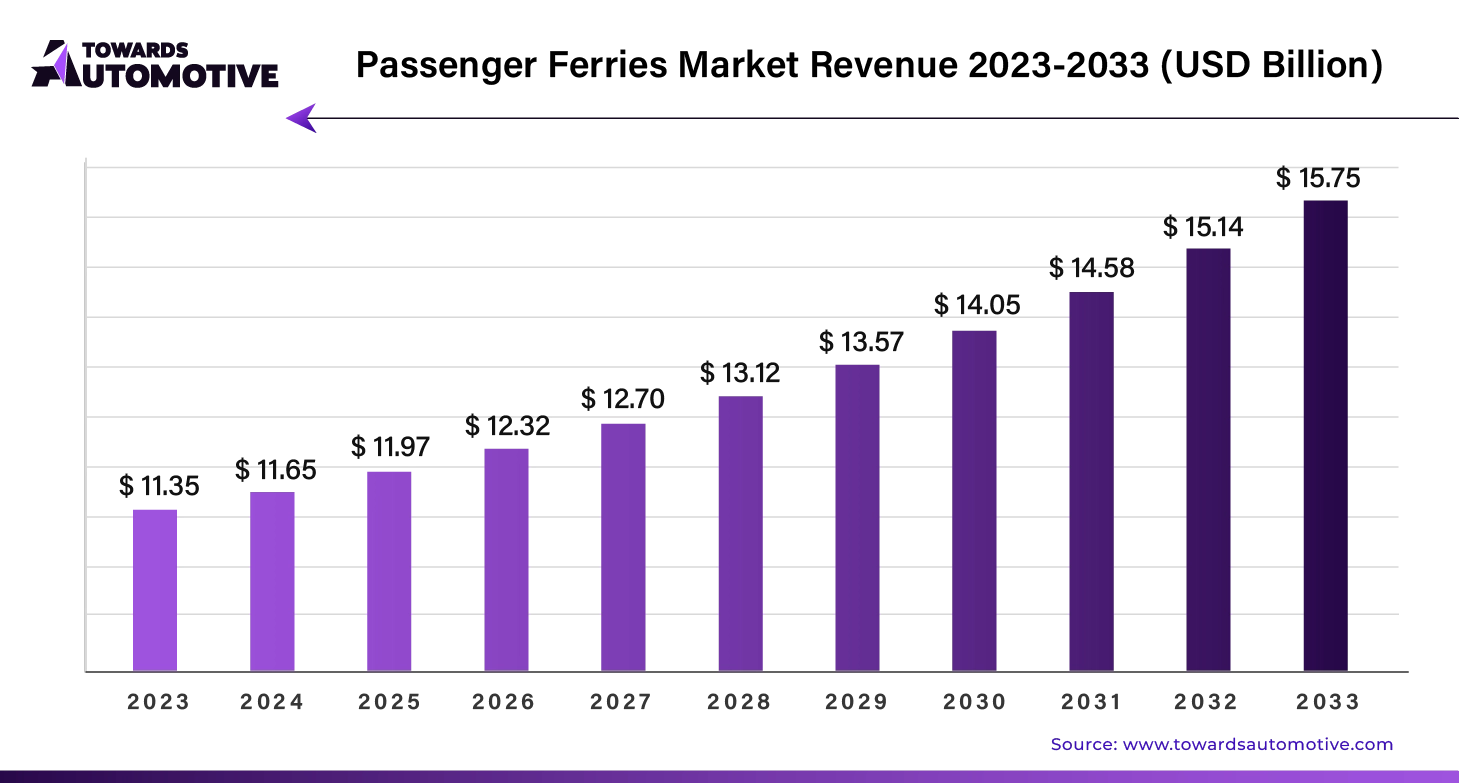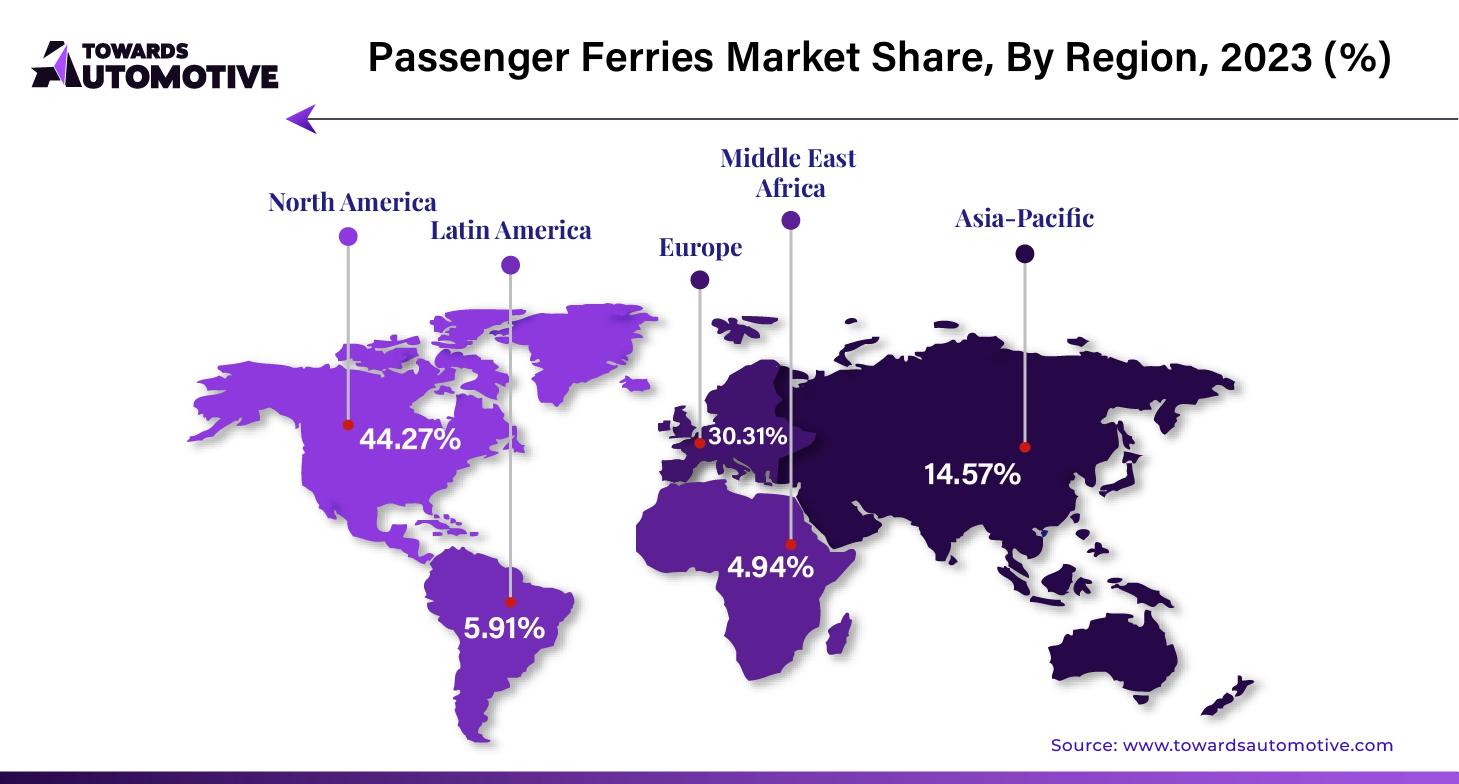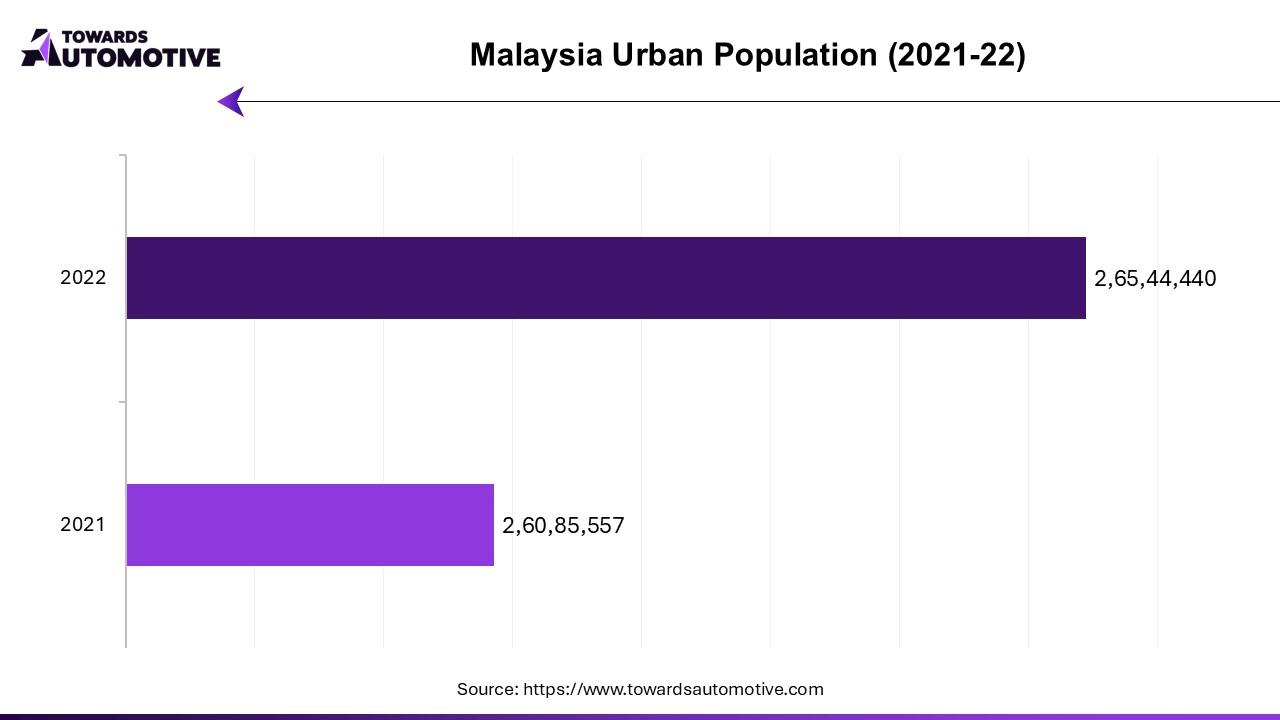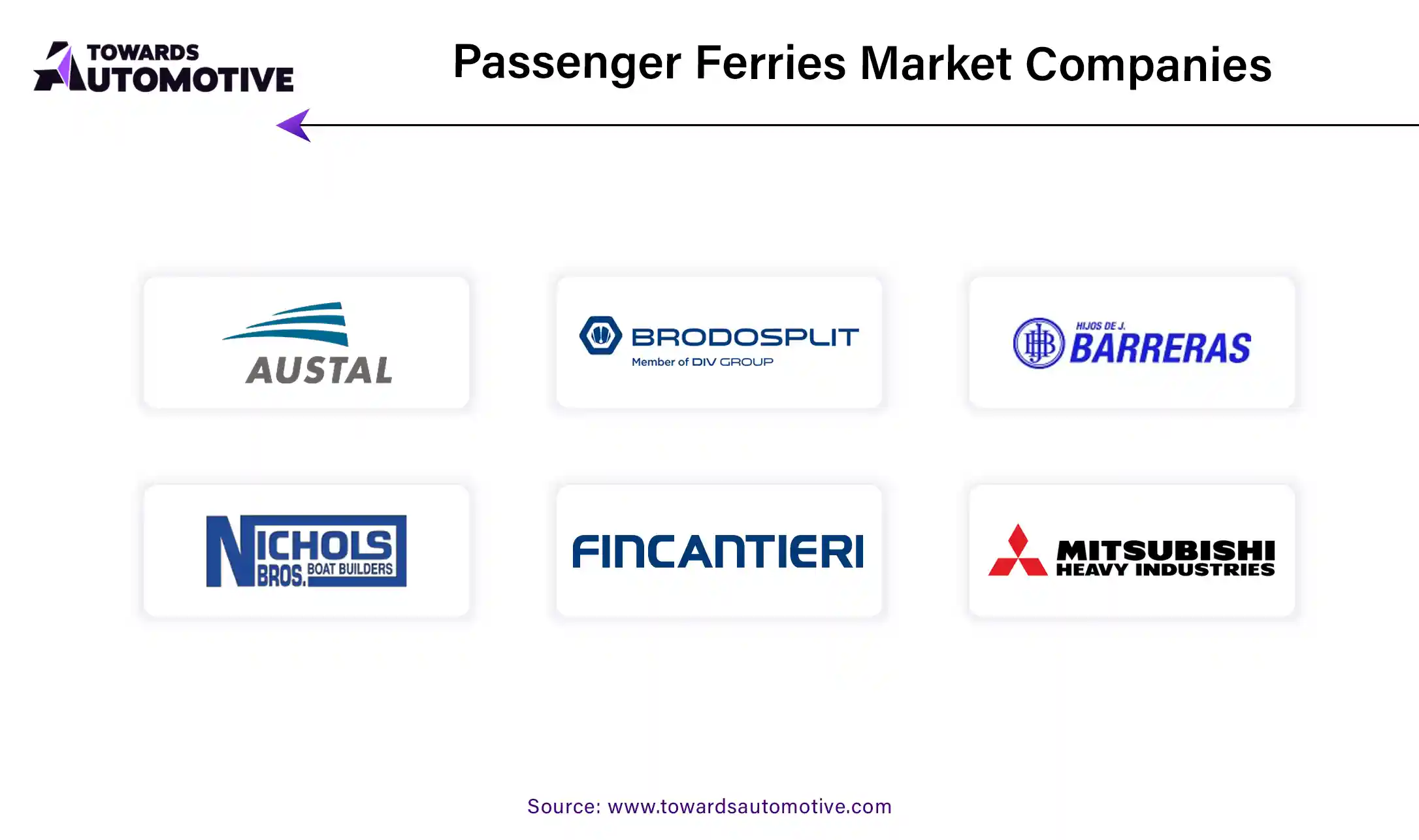April 2025

Senior Research Analyst

Reviewed By
The passenger ferries market is projected to reach USD 16.41 billion by 2034, growing from USD 12.14 billion in 2025, at a CAGR of 3.41% during the forecast period from 2025 to 2034.

The passenger ferries market is a vital segment of the maritime transportation industry, providing essential services for both local commuters and tourists. This market encompasses a range of vessels designed to transport passengers across various water bodies, including rivers, lakes, and coastal areas. Passenger ferries are particularly significant in regions with numerous islands, extensive coastlines, and urban areas separated by water, where they serve as a primary mode of transportation. The growth of this market is driven by several factors, including increasing urbanization, rising tourism, and the need for efficient transportation solutions.
Urbanization is leading to the expansion of coastal cities and towns, prompting a higher demand for efficient intermodal transportation options. Ferries are often faster and more environmentally friendly than road or rail alternatives, making them an attractive choice for commuters. Additionally, with the rising popularity of tourism in coastal and island destinations, passenger ferries play a crucial role in enhancing accessibility, offering scenic routes that attract leisure travelers. This has led to the development of more advanced and comfortable ferry designs, equipped with amenities such as onboard dining, Wi-Fi, and entertainment systems to enhance the passenger experience.
Furthermore, technological advancements are influencing the passenger ferries market, with operators increasingly adopting hybrid and electric propulsion systems to reduce emissions and improve fuel efficiency. Government regulations aimed at promoting sustainable transportation solutions are further incentivizing the transition to greener technologies within the sector.
Moreover, the COVID-19 pandemic has reshaped the market landscape, leading to increased health and safety measures aboard ferries, including enhanced cleaning protocols and social distancing measures. As the world moves towards recovery, the passenger ferries market is expected to rebound, with growth driven by ongoing urbanization, technological innovations, and a renewed focus on sustainable transportation solutions. This multifaceted market continues to adapt to changing consumer preferences and regulatory environments, positioning itself for a robust future.
Artificial intelligence (AI) is increasingly playing a transformative role in the passenger ferries market, enhancing operational efficiency, safety, and the overall passenger experience. One of the most significant applications of AI in this sector is in predictive maintenance. By analyzing data from onboard systems and sensors, AI can forecast potential mechanical issues before they occur, allowing ferry operators to perform timely maintenance and reduce the risk of unexpected breakdowns. This proactive approach not only minimizes operational disruptions but also enhances safety for passengers and crew.
AI is also being utilized to optimize routing and scheduling. Through advanced algorithms and real-time data analysis, AI can evaluate factors such as weather conditions, traffic patterns, and passenger demand, enabling ferry operators to adjust routes and schedules dynamically. This adaptability enhances operational efficiency, reduces fuel consumption, and improves punctuality, ensuring that vessels can better meet passenger expectations.
In terms of customer service, AI-driven chatbots and virtual assistants are being deployed to assist passengers with inquiries, bookings, and navigation information. This technology enhances the passenger experience by providing quick and accurate responses, ultimately improving customer satisfaction. Additionally, AI can analyze passenger data to offer personalized services and promotions, tailoring the travel experience to individual preferences.
Moreover, AI enhances safety through advanced surveillance systems that use facial recognition and behavior analysis to identify potential security threats. These systems can alert crew members to unusual behavior or situations, ensuring a safer environment for all onboard.
As the passenger ferries market continues to evolve, the integration of AI technologies is expected to drive innovations that enhance efficiency, safety, and the overall travel experience, positioning operators to better compete in a rapidly changing transportation landscape.
The rise in waterway transportation is significantly driving the growth of the passenger ferries market, as more regions recognize the advantages of utilizing waterways for efficient travel and logistics. As urban populations expand and traffic congestion becomes increasingly problematic, many cities are turning to ferry services as a viable alternative to traditional land-based transport. Ferries offer a fast, reliable, and environmentally friendly means of transportation across rivers, lakes, and coastal areas, helping to alleviate the pressure on congested road networks. This shift toward waterway transportation is particularly evident in densely populated urban centers where the availability of waterways can be leveraged to enhance public transit systems.
In addition to reducing congestion, the rise of waterway transportation is being fueled by significant government investments in maritime infrastructure. Authorities are increasingly allocating resources to develop and modernize ferry terminals, improve navigational aids, and ensure safe and efficient operations. These initiatives not only enhance the attractiveness of ferry services but also encourage greater adoption by commuters and tourists alike. Moreover, as urban planners emphasize sustainable development, waterway transportation is gaining traction as an eco-friendly alternative to fossil fuel-dependent vehicles, aligning with global efforts to reduce carbon emissions.
The growing tourism sector also contributes to the rise in waterway transportation. Many coastal and lakeside destinations are increasingly promoting ferry services as a means to explore scenic areas, thus driving demand for passenger ferries. The convenience of water travel, combined with the allure of scenic views, attracts both leisure travelers and local residents seeking quick and enjoyable transport options.
As awareness of the benefits of waterway transportation continues to rise, the passenger ferries market is poised for robust growth. The combination of urbanization, government support, and increasing consumer interest in sustainable travel solutions positions ferry services as a pivotal element in the broader transportation landscape.
The passenger ferries market faces several restraints that may hinder its growth. One significant challenge is the high operational and maintenance costs associated with ferry services, including fuel expenses, crew wages, and vessel upkeep, which can limit profitability. Additionally, regulatory hurdles and stringent safety standards can complicate the approval and operation of ferry services, particularly in heavily trafficked waterways. Seasonal fluctuations in demand can also affect revenue stability, as some routes may experience reduced patronage during off-peak periods. Finally, competition from alternative transportation modes, such as buses and trains, poses a threat to the expansion of the passenger ferries market.
Hydrogen-based ferries are creating significant opportunities in the passenger ferries market, particularly as the demand for sustainable and environmentally friendly transportation solutions continues to rise. As countries and cities work towards reducing their carbon footprints, hydrogen fuel cell technology emerges as a promising alternative to traditional fossil fuels. Hydrogen-powered ferries produce zero emissions at the point of use, significantly lowering air pollution levels in coastal regions and aligning with global sustainability goals. This eco-friendly approach not only meets regulatory requirements but also enhances the attractiveness of ferry services to environmentally conscious travelers.
The development of hydrogen-based ferries offers ferry operators a unique opportunity to differentiate their services in a competitive market. By adopting this cutting-edge technology, operators can appeal to a growing segment of eco-aware consumers who prioritize sustainability in their travel choices. This shift towards greener transportation can enhance brand reputation and foster customer loyalty, leading to increased ridership and revenue growth. Furthermore, hydrogen-powered ferries can potentially operate at lower fuel costs in the long run, as the technology matures and the production of green hydrogen becomes more economically viable.
Additionally, the growing investment in hydrogen infrastructure, including production, storage, and fueling stations, presents further opportunities for the passenger ferries market. As governments and private enterprises collaborate to develop a comprehensive hydrogen supply chain, ferry operators can benefit from improved access to hydrogen fuel, enhancing operational efficiency and expanding service offerings. Collaborations with technology providers and research institutions can also facilitate innovation in vessel design and performance, making hydrogen ferries more viable and attractive.
The private booking segment led the industry. The private booking segment is becoming increasingly influential in driving the growth of the passenger ferries market, as more travelers seek personalized and exclusive travel experiences. This trend is particularly evident among tourists and local residents looking for unique ways to explore coastal regions and picturesque waterways. Private bookings offer customers the opportunity to charter entire vessels for special occasions, such as weddings, corporate events, family gatherings, or private tours, allowing for a tailored experience that can include customized itineraries, onboard catering, and specialized services.
As consumers become more discerning in their travel preferences, the demand for personalized services continues to rise. The private booking segment caters to this desire by providing flexibility and exclusivity that traditional ferry services may not offer. This includes the ability to select departure times, customize routes, and choose specific onboard amenities. Additionally, private bookings often enable travelers to avoid crowded public ferries, enhancing comfort and providing a more intimate atmosphere. This exclusivity appeals to high-net-worth individuals and groups looking for premium experiences, further driving revenue for ferry operators.
Moreover, the rise of digital platforms and mobile applications has simplified the booking process, making it easier for customers to arrange private charters. Online booking systems allow for quick reservations, real-time availability checks, and user-friendly interfaces, which attract a broader audience, including those who may not have previously considered ferry travel. Operators are increasingly investing in marketing strategies that highlight the benefits of private bookings, promoting the unique experiences and advantages they provide.
The multihull segment held the dominant share of the market. The multihull segment is playing a crucial role in driving the growth of the passenger ferries market, primarily due to its inherent advantages in stability, speed, and passenger comfort. Multihull ferries, which include catamarans and trimarans, are designed with two or more hulls that provide superior stability compared to traditional monohull vessels. This design minimizes the impact of waves and turbulence, resulting in a smoother ride for passengers, which is particularly appealing for those prone to seasickness. The enhanced stability allows operators to offer services in a broader range of sea conditions, increasing the operational efficiency of ferry services and expanding route options.
Furthermore, the multihull design allows for greater deck space and passenger capacity without significantly increasing the vessel's overall length. This is particularly advantageous for ferry operators looking to maximize the number of passengers they can accommodate on popular routes. The spacious decks can also be utilized for amenities such as lounges, cafes, and viewing areas, enhancing the overall travel experience and encouraging more passengers to choose ferries as their preferred mode of transportation.
Technological advancements in multihull design and construction are also contributing to this segment's growth. Modern materials and construction techniques have made it possible to produce lightweight yet durable multihull vessels, improving fuel efficiency and reducing operational costs. Additionally, many new multihull ferries are being designed with eco-friendly features, such as hybrid or electric propulsion systems, aligning with the growing demand for sustainable transportation options.
As ferry operators increasingly recognize the benefits of multihull vessels, investments in this segment are expected to rise. The combination of enhanced passenger comfort, increased capacity, and operational efficiency positions the multihull segment as a key driver of growth in the passenger ferries market, catering to the evolving needs and preferences of modern travelers.

North America dominated the passenger ferries market. Population growth in coastal cities, coupled with the rise of the tourism industry and an increase in private bookings, significantly drives the growth of the passenger ferries market in North America. As urban centers such as New York, San Francisco, and Miami continue to expand, the demand for efficient and reliable transportation options is growing. Ferries serve as a crucial alternative to traditional road and rail services, offering a faster and often more scenic mode of travel across busy waterways. This trend is particularly prominent in metropolitan areas where traffic congestion is prevalent, making ferry services an attractive option for daily commuters seeking to avoid long travel times and overcrowded public transit.
Simultaneously, the burgeoning tourism industry in North America plays a pivotal role in enhancing ferry services. Coastal cities and scenic destinations, such as the Florida Keys and the Pacific Northwest, attract millions of tourists annually. Ferries not only facilitate access to these picturesque locations but also enhance the overall travel experience by providing breathtaking views and unique adventures. The development of specialized ferry routes catering to tourists—such as sightseeing tours and day trips—further contributes to market growth, as operators capitalize on the increasing interest in exploring coastal regions and islands.
Additionally, the trend toward private bookings and charter services is gaining momentum. Travelers are increasingly seeking personalized and exclusive experiences, prompting ferry operators to offer private charters for special events, corporate outings, and family gatherings. This shift allows operators to cater to diverse customer preferences, enhancing revenue streams and fostering loyalty among clients.

Asia Pacific is expected to grow with a significant CAGR during the forecast period. Government initiatives aimed at enhancing transportation infrastructure, rapid urbanization, and technological advancements significantly drive the growth of the passenger ferries market in the Asia-Pacific (APAC) region. As urban centers expand, many coastal cities are investing in integrated transportation systems that include ferry services to ease traffic congestion and improve connectivity. Governments recognize that ferries can serve as a vital mode of public transport, linking islands and mainland areas while providing a sustainable alternative to road transport. Investments in ferry terminals, docking facilities, and navigational aids enhance operational efficiency and passenger safety, encouraging increased ferry usage among commuters and tourists alike.
Rapid urbanization in the APAC region has led to a growing population in coastal cities, intensifying the demand for efficient public transportation solutions. As city dwellers seek to navigate increasingly crowded urban environments, ferries provide a fast, scenic, and environmentally friendly option. This rising urban population also contributes to the tourism sector, as more travelers flock to coastal cities and popular tourist destinations, further driving the demand for reliable ferry services.
Technological advancements play a critical role in enhancing the passenger ferries market as well. The introduction of modern, high-speed ferries equipped with advanced navigation systems and improved safety features enhances the overall travel experience. Additionally, the shift toward eco-friendly propulsion technologies, such as electric and hybrid engines, aligns with growing environmental concerns and government regulations promoting sustainability. These innovations not only reduce emissions but also lower operational costs, making ferry services more competitive against other modes of transportation.


By Booking Type
By Type
By Region
April 2025
March 2025
March 2025
March 2025
Dr. Arjun Patel is a distinguished expert in the automotive industry, holding advanced degrees in Automotive Engineering and Mechanical Engineering. His expertise spans automotive market dynamics, technological advancements, and sustainable practices. Dr. Patel excels in conducting in depth research and analysis on market trends, consumer preferences, and the economic implications within the automotive sector. He is renowned for his insightful publications on topics such as electric vehicles, autonomous driving technologies, and the evolution of sustainable transportation solutions. Dr. Patels research contributions have significantly advanced understanding in the field, earning him recognition as a leading authority in automotive research and analysis.
We offer automotive expertise for market projections and customizable research, adaptable to diverse strategic approaches.
Contact Us